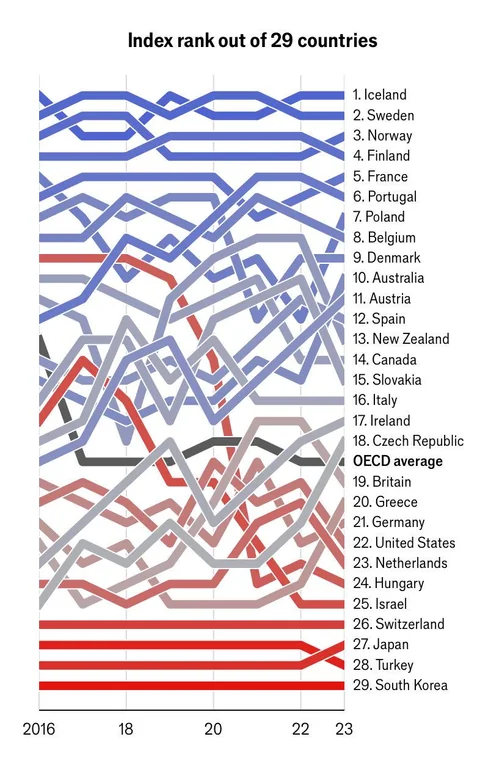The Economist’s glass-ceiling index
Our annual measure of the role and influence of women in the workforce
ARE WORKING conditions getting any better for women? The Economist’s “glass-ceiling index” offers some clues. Each year, to mark International Women’s Day on March 8th, we crunch the numbers on ten indicators—from labour-force participation and salaries to paid parental leave and political representation—for 29 members of the OECD, a club of mostly rich countries. Since we started in 2013 the pace of change has been glacial, but in most places things are at least moving in the right direction. Our chart below shows where women’s professional opportunities are greatest relative to those of men.
Iceland came first for the second year in a row. In fact, Nordic countries have always dominated the top of the index, scoring highly on all our measures. The bottom also has a familiar feel: women in South Korea, Japan and Turkey still face the biggest workplace obstacles. Australia and Poland were the biggest climbers, both up five spots from last year. Our ten charts below give a closer look at each indicator.
The first three broadly measure economic participation. In almost every country women graduate from university in greater numbers than men. Yet they make up a lower share of the workforce across our index. This is most notable in Turkey, Greece and Italy, where less than two-thirds of adult women are employed. The gap in labour-participation rates means that fewer women climb the corporate ladder, which feeds into the gender wage gap. In the OECD women earn around 12% less than men.
The next three indicators show the progress of women in business. Among people who took the GMAT, the de facto entrance exam for MBA programmes, the share of women fell slightly across the board. But women’s representation in senior management roles in the OECD reached 34.2%, up from 33.8% last year. Sweden, America and Poland are particularly impressive on this measure, with women holding more than 40% of high-level jobs. In Japan and South Korea the proportion is a disappointing 15% and 16%, respectively.The share of company board members who are women hit 33% across the OECD for the first time. In the EU women must make up 40% of board directors by 2026. So far only five of the 22 EU members in our index have reached that target (and all of those surpassed it).
Starting a family can make it hard for many women to stay in the workforce (an issue dubbed the motherhood penalty). Two factors can help them do both: generous parental leave and affordable child care. The length of paid maternity leave varies widely: Hungary, Greece, Slovakia and the Nordics are generous. America remains the only rich country where the government does not require employers to offer new mothers a minimum amount of leave. Leave for fathers is also important—it helps divide the burden of child care between parents. To encourage more women to enter the workforce, Japan and South Korea have enacted the most generous paternity-leave policies in the OECD (with 31 and 22 weeks, respectively, when adjusted for full pay) though few new fathers choose to stay at home.Another measure for parents is the cost of child care. The Fawcett Society, a gender-equality campaign group, recently estimated that 250,000 British mothers with children under the age of four had left the workforce. Its study cited the cost of child care and a lack of employer flexibility. Child-care costs take up around 25% of the average wage in Britain, compared with an average of 14% across the OECD.
Finally, to politics. Studies have shown that more women in political leadership leads to a greater focus on women’s rights and family policies. In Iceland, Sweden, Norway and Finland—the top four countries on our index—women hold at least 45% of parliamentary seats. In South Korea and Japan, on the other hand, their share is below 20%.Not all of our measures have equal weighting. Those concerning motherhood, for example, have less weight than those that affect all women, such as labour-participation rates. This year’s average score is slightly higher than last year’s, though on most indicators the rate of improvement has been slow. In most countries women are still struggling to break through the glass ceiling.
Latest data available.
*Population (aged 25-64) with tertiary education. †Female minus male rate. ‡Male minus female wages, divided by male wages.
**Lower or single house. §Shared parental leave is allocated to mothers; net earnings for Austria, France and Germany.
Sources: European Institute for Gender Equality; Eurostat; MSCI ESG Research; GMAC; ILO; Inter-Parliamentary Union; OECD; national sources; The Economist
https://www.economist.com/graphic-detail/glass-ceiling-index



